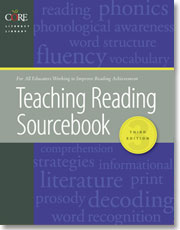
Author(s): Bill Honig / Linda Diamond / Linda Gutlohn
(CORE) Consortium On Reaching Excellence in Education
www.corelearn.com
Assessing Reading: Multiple Measures, Revised 2nd Edition provides a collection of tests for the comprehensive assessment of skills related to reading.
This collection of easy-to-use formative assessments help content-area teachers identify students who may need additional support in multisyllabic word identification to independently read and comprehend their grade-level English Language Arts, Mathematics, Science, and Social Studies texts.
Set A1 focuses on CVC short vowel words, final double consonant and -ck ending, inflectional ending -s, open-syllable long vowels, CVCe long vowel words, long vowel pairs and soft c and g.
Set A-2 gives students more opportunities to practice decoding one-syllable words. Three books focus on short vowels; three on both short and long vowels.
Three books in Set B1 focus on blends of 2 or 3 consonants and final y as long i, and three books focus on variant vowel pairs and diphthongs.
Three books in set focus on initial silent letters, consonant digraphs and final digraphs, three focus on diphthongs, r-controlled vowels, and initial silent letters.